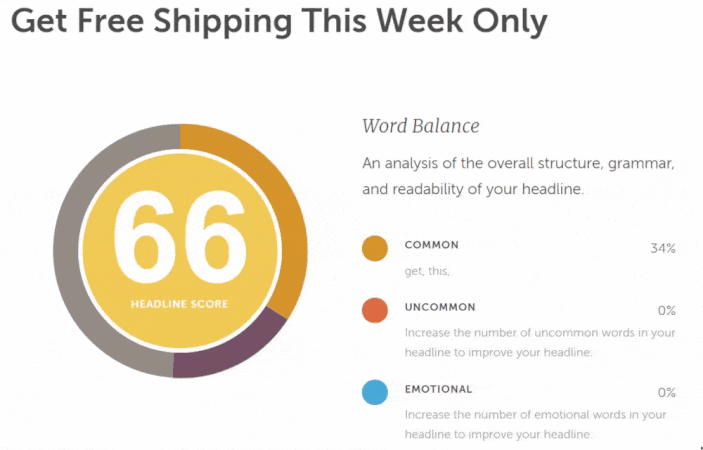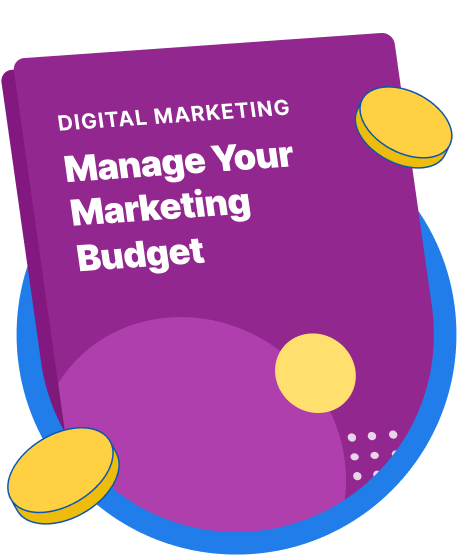-
 11 min. read
11 min. read
-
 Sarah Berry
Sarah Berry Web Marketing Consultant
Web Marketing Consultant
- Sarah Berry is a Google Analytics-certified Web Marketing Consultant at WebFX. She’s written over 400 articles on digital marketing, covering topics like SEO, CRO, and Amazon. When she isn’t polishing her Time Magazine Person of the Year Award, she’s spending time with her flock of ducks.
“$44 for every $1 invested — yeah, right!” Suppose that’s what you’re thinking every time you hear someone talk about email marketing’s impressive return on investment (ROI). In that case, you might want to think about introducing A/B testing to your email strategy. Keep reading to get all the details on how to A/B test email campaigns, including:
- What is A/B testing in email marketing?
- What can I test in an email?
- Why should I test my emails?
- How do I start A/B testing email campaigns?
- What are some email testing best practices to follow?
Email A/B testing is a proven tactic for getting more value from email marketing. That’s because these tests help you understand your audience. You can learn what offers, phrases, or even emojis motivate them to open and act on your emails.
Then, you can use that knowledge across email campaigns to drive leads, sales, and an impressive ROI. If you’re looking to experiment with A/B testing for your email campaigns, check out our email marketing software, EmailMarketingFX!
What is A/B testing in email marketing?
 In email marketing, A/B testing or split testing is the process of creating and sending two variations of an email campaign to two subscriber subsets and then determining which version performs best. Companies use split testing in email marketing to understand their subscribers better.
In email marketing, A/B testing or split testing is the process of creating and sending two variations of an email campaign to two subscriber subsets and then determining which version performs best. Companies use split testing in email marketing to understand their subscribers better.
What can I test in an email?
You can test a range of elements with email A/B testing.
A few examples include:
- Subject lines
- Personalization
- Images
- Length
- Layout
- Call to action (CTA)
- Offer
Limit your A/B tests to one element at a time for the best results. For example, experiment with two variations (A and B) of your subject line instead of testing two variations of your subject line and two variations of your CTA. When you limit yourself to testing one element, you make it easier to determine which changes influenced your results.
Why do email A/B testing?
Depending on what you test, like your email campaign’s design, split testing can require a bit of time.
It’s worth the investment, though, which is why more than 60% of businesses A/B test their emails. A few reasons you should consider split testing your emails include:
Get immediate feedback from your target audience
Whenever you send an email, you get instant passive feedback from your target audience. Based on whether they opened your email, interacted with it, or acted on your CTA, you can understand whether you hit or missed the mark.
When you introduce A/B testing to your email strategy, you can get further feedback from your subscribers. Do they like it more when you offer free shipping versus 10% off, for example? Or, are they more likely to see your email when you send it in the morning versus the afternoon?
You can answer both questions with consistent A/B testing — and use that feedback to improve your entire email strategy.
Understand what CTAs, subject lines, and layouts work best
With continuous A/B testing, you can learn what works best for your audience. One test may suggest subscribers love your free shipping offer. With consistent testing, you can confirm whether that offer is more persuasive than everything else you provide, like dollar or percentage discounts.
This benefit of split testing allows you to incorporate data into your email marketing strategy. You stop guessing about whether subscribers will like an offer or respond to a specific CTA and instead gather data to prove (or disprove) your ideas.
Use A/B test takeaways on other channels
Once you discover which offers, phrases, or layouts work best, you can multiply that benefit by using them across email campaigns. In some cases, you may even extend those takeaways to other places, like your website or social media accounts.
For example, maybe the following CTA language works well: “Treat Yourself.” In response, you open Google Optimize, which allows you to conduct A/B testing on your website for free, and start testing that language on your site. You discover that “Treat Yourself” also works well on your site pages, which helps you convert more website visitors into customers. The above scenario is an excellent example of how you can multiply the benefits of email A/B testing.
How to start A/B testing your email campaigns
Are you ready to learn how to split test your email campaigns?
Get started now:
1. Pick what you’ll test
First, decide what you’ll test. A few options include:
- Subject line
- Offer
- CTA
- Delivery time
- ‘From’ name
If you use email management software, like EmailMarketingFX or Mailchimp, it will make setting up your A/B test easy. With EmailMarketingFX, for instance, you can select whether you want to A/B test your subject line or email content.  When it comes to deciding what you’ll test, the following questions can help:
When it comes to deciding what you’ll test, the following questions can help:
- What is the goal of this email?
- Who is our audience?
- What action do we want subscribers to take?
- What metric, like open rates, do we want to improve?
If you’re looking to drive orders as part of a limited-time promotion, for instance, you may choose to A/B test your subject line to encourage more opens or your CTA to motivate more subscribers to visit your website and place an order. Once you decide which element you’ll test, you’ll want to create your A/B variations.
2. Determine how you’ll measure your results — and success
Before launching your email A/B test, determine how you’ll measure your success. Which metric will determine whether you classify version A as the winner or version B? For example, if you’re A/B testing your subject line, you may use the open rate to determine the winner.
In comparison, if you’re split testing your email’s CTA, you may reference the percentage of people that clicked on the CTA. No matter how you approach this task, choose something measurable.
3. Decide who you’ll test
Finally, decide who you’ll test. This is your A/B test sample size. Depending on your business, you may A/B test your entire list of email subscribers.
Or, you may choose only to include a portion of your email subscribers in the split test. Your decision will likely depend on the size of your subscriber list, as you want to get statistically significant results from your A/B test. Getting statistically significant results generally requires having at least 1000 subscribers in your test.
If you have less than 1000 subscribers, that doesn’t mean you shouldn’t A/B test. You can still split test and use your results to understand your audience better. As your list grows, though, you’ll likely see shifts in user behavior.
Again, if you use email management software, it’ll make setting your test audience easy.  In EmailMarketingFX, for example, you can set the percentage of subscribers that you want to A/B test. If you’re managing your campaign without email software, this step can become tedious.
In EmailMarketingFX, for example, you can set the percentage of subscribers that you want to A/B test. If you’re managing your campaign without email software, this step can become tedious.
It’s time-consuming to separate subscribers into A and B groups. Plus, hand-picking subscribers make split tests less objective, which can hurt test accuracy. That’s why having email management software is often a must for A/B testing emails.
5 email testing best practices to follow for your next A/B test
Now that you know how to split test email campaigns, set yourself up for success with these five email testing best practices:
1. Test elements with the most impact first
Generally, you’ll want to test elements with the most impact. Your subject line, for example, can have a massive influence on your email marketing performance. It determines whether people will open your email, which is essential.
If someone doesn’t open your email, they can’t act on your CTA — or help you see which CTA performs better. Work on the outside of your email first, like its subject line and sender name, and then move inside to your layout, content, CTAs, and other elements. This approach will help you improve metrics, like open rate, that serve as steppingstones to larger ones, like conversions.
2. Ask “why” after every email A/B test
When it comes to A/B testing emails, it’s not enough to say, “A won, B lost.” You need to ask why. Why did version A win and version B lose? Look at the differences between your two versions.
Think about the impact those differences may have had on your audience. Did you offer a free shipping code in your subject line, for example, instead of a 10% off coupon? This difference could suggest that your audience finds free shipping more persuasive than 10% off.
Asking “why?” helps you get the most value from A/B testing your email campaigns. You have takeaways that you can incorporate into future emails. Settle for A/B testing without the “why,” and you settle for a subpar email marketing strategy.
3. Prioritize A/B tests with ICE
Whether you’re working alone or with a team, you probably have some initial A/B test ideas. From subject lines to button colors, you have plenty of options when it comes to experimenting with your emails. Subscribers aren’t looking to get spammed with emails, though.
You’ll have to practice patience and test your emails over time, which means prioritizing all your test ideas. One acronym can help you organize and prioritize your email A/B tests: ICE, which stands for Impact, Confidence, and Ease. ICE asks the following questions:
- How much of an impact could this test have?
- How confident are you that this test will have a positive impact?
- How easy is it to implement this test?
You can incorporate ICE into your email marketing efforts with a simple Google Sheet.  Just enter your ideas, and then a score for each ICE category. You could even color-code your scores, so it’s easy for everyone to understand whether a rating of three, for instance, means the test is harder or easier to implement.
Just enter your ideas, and then a score for each ICE category. You could even color-code your scores, so it’s easy for everyone to understand whether a rating of three, for instance, means the test is harder or easier to implement.
This step may seem unnecessary, but prioritizing your tests will help you strategize your A/B tests.
4. Use free email marketing tools
With some free email marketing tools, you can get even more value from your split tests. Headline Analyzer from CoSchedule, for example, is a handy tool for checking the quality of your subject lines. It’ll grade your subject line and provide feedback for how you can make it more persuasive and likely to draw attention.
 Sender Score is another valuable email marketing tool. This free tool will check your sender’s reputation, which influences the deliverability of your emails. If you have a less-than-stellar reputation, that can affect how many people receive your emails, which can impact your email A/B testing efforts.
Sender Score is another valuable email marketing tool. This free tool will check your sender’s reputation, which influences the deliverability of your emails. If you have a less-than-stellar reputation, that can affect how many people receive your emails, which can impact your email A/B testing efforts.
5. Preview every A/B test before sending
People check and read emails on a range of devices, from their tablets to their desktops. They also use a variety of browsers and email clients, from Chrome to Microsoft Outlook. That’s why it’s vital to preview your email across these devices, browsers, and email clients before sending it to the masses.
Most email management applications, like EmailMarketingFX, will allow you to send test emails. This feature can make checking your A/B tests easy. Even if you aren’t A/B testing, it’s a best practice to double-check your emails for typos, missing links, and other errors.
Since you only get one chance to send your emails, it’s essential to test them beforehand.
93% of WebFX customers are extremely satisfied with their digital marketing results.
“Working with WebFX, everything is very organized and strategic. We’re only a year into our partnership, and our expectations have definitely been met.”
View More Client Testimonials

Start your first email A/B test for free with EmailMarketingFX
Email A/B testing is a smart tactic to include in your email marketing strategy. Split testing your emails helps you learn more about your audience and incorporate those takeaways into future emails to generate not only more clicks and conversions but also create compelling email content. If you’re ready to run your first email A/B test, you can get started for free with EmailMarketingFX!
For professional help with your email marketing strategy, as well as A/B testing, contact us online or call us at 888-601-5359 to learn how our email marketing services can make email a revenue-driving channel for your business!
-
 Sarah Berry is a Google Analytics-certified Web Marketing Consultant at WebFX. She’s written over 400 articles on digital marketing, covering topics like SEO, CRO, and Amazon. When she isn’t polishing her Time Magazine Person of the Year Award, she’s spending time with her flock of ducks.
Sarah Berry is a Google Analytics-certified Web Marketing Consultant at WebFX. She’s written over 400 articles on digital marketing, covering topics like SEO, CRO, and Amazon. When she isn’t polishing her Time Magazine Person of the Year Award, she’s spending time with her flock of ducks. -

WebFX is a full-service marketing agency with 1,100+ client reviews and a 4.9-star rating on Clutch! Find out how our expert team and revenue-accelerating tech can drive results for you! Learn more
Try our free Marketing Calculator
Craft a tailored online marketing strategy! Utilize our free Internet marketing calculator for a custom plan based on your location, reach, timeframe, and budget.
Plan Your Marketing Budget

Maximize Your Marketing ROI
Claim your free eBook packed with proven strategies to boost your marketing efforts.
Get the GuideTry our free Marketing Calculator
Craft a tailored online marketing strategy! Utilize our free Internet marketing calculator for a custom plan based on your location, reach, timeframe, and budget.
Plan Your Marketing Budget





